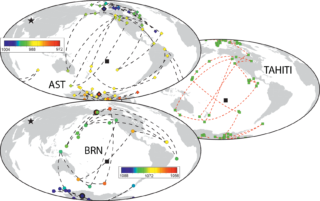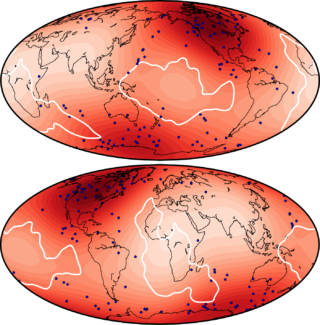Lower mantle influence on geomagnetic field reversals
Generally, we use paleomagnetic data to reconstruct the paleoposition of continental blocks to establish a paleogeographic framework of the world throughout Earth’s history. However, there are other ways to deduce valuable information from the rapidly changing geomagnetic field on the long term evolution of the Earth. One way is to utilize the influence of core-mantle boundary heat flux on the geomagnetic field. This interaction has been proposed to be the cause of variation in paleomagnetic reversal rates throughout the Phanerozoic. Additionally, it has been suggested that heterogeneity in heat flux causes a specific pattern of transitional paleomagnetic poles (or virtual geomagnetic pole – VGP) during a reversal of the magnetic polarity. It has been speculated for some time that transitional poles are arranged on the rims of the large low shear velocity provinces (LLSVPs) at the core mantle boundary. If proven to be correct, this relationship has the potential to give valuable constraints on the stability of LLSVPs over time, which has a direct influence on the supercontinent cycle theory.
In this study we investigated a sedimentary sequence in the territory of Armenia, where the two geomagnetic field reversals bounding the youngest normal polarity subchron (the so called Jaramillo subchron with an age between 0.988 and 1.072 Ma), prior to the current Brunhes normal polarity chron, have been recorded. The paleomagnetic signal in this sediment is of very high quality. Because these lake deposits were accumulated very rapidly (sedimentation rate of ~30cm/ka), it was possible to study the field reversals on a length of ~2m. We obtained standard, 1 inch diameter, paleomagnetic samples at a very high resolution, intervals of less than 10 cm. Based on the paleomagnetic results we calculated, for each sample level, a geomagnetic pole assuming a dipole dominated geomagnetic field (therefore virtual). Plotting these poles allowed us to investigate the appearance of the geomagnetic field during a polarity transition (or field reversal).

The obtained virtual geomagnetic pole (VGP) path indicates an oscillatory transitional field behaviour with four abrupt transequatorial precursory jumps across the Pacific (Fig.1). The two records are strikingly similar to another high quality paleomagnetic record (green in figure 1), which is based on a volcanic sequence from Tahiti. The distribution of VGP positions of ours and the Tahitian records clearly indicate regions of preferred occurrence (Fig.2). Our results are in agreement with previously proposed bands of transitional VGP occurrence over the Americas and Australia/northwest Pacific. Additionally, our VGP positions undoubtedly avoid areas, under which large low shear velocity provinces (LLSVPs) are located at the core mantle boundary (CMB, Fig.2).

We suggest an explanation for our observations by a thermally stable zone within the outer core and below the LLSVPs, which persists throughout the polarity transition. This zone can generate a secondary radial dipole, which repels the transitional VGPs directly above this zone. In this way, as long as the LLSVPs are in place, all polarity transitions should look similar, which has been observed for the youngest polarity transitions.
Our data proves that there is an obvious link between paleomagnetic reversal geometries and lower mantle structures. In future studies we might use this as a basis to investigate temporal evolution of the lower mantle after identifying other high quality reversal records from older sequences. We showed that with only three high quality records and a robust statistical analysis we can visualize an antipodal structure at the CMB. Analysis of reversals from other critical time periods might yield information on how stable these features at the CMB actually are.
Relevant publication:
Kirscher, U., Winklhofer, W., Hackl, M., Bachtadse, V., 2018. Detailed Jaramillo field reversals recorded in lake sediments from Armenia – Lower mantle influence on the magnetic field revisited. Earth and Planetary Science Letters, 484, 124-134. https://doi.org/10.1016/j.epsl.2017.12.010
